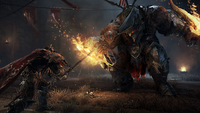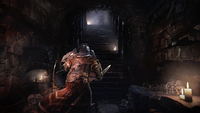|
|

|
PLATFORM
|
PS4
|
BATTLE SYSTEM
|

|
INTERACTION
|

|
ORIGINALITY
|

|
STORY
|

|
MUSIC & SOUND
|

|
VISUALS
|

|
CHALLENGE
|
Moderate
|
COMPLETION TIME
|
Less than 20 Hours
|
|
OVERALL

|
+ Amazing visuals and solid sound presentation
+ Tweaked formula more friendly to newcomers
- Plot is tiresome and predictable
- Environments feel ignored and underutilized
|
Click here for scoring definitions
|
|
|
Let's be honest. Gamers who have developed a taste for the Demon's Souls brand of earning victory by paying with defeat after defeat will need little convincing on the topic of whether or not to pick up Lords of the Fallen. The game's unofficial tagline alone — Dark Souls, with Vikings — will be enough to seal the deal for many. Indeed, as one-sentence summaries go, this is an adept encapsulation of what Deck13 Interactive's action RPG is all about. But although it borrows heavily from its obvious inspirations, its general lack of challenge and lackluster gameworld make it feel a little too much like a flashy and well-polished Xerox copy pretender to the throne.
Lords of the Fallen makes an honest attempt at a narrative to back up its combat-based gameplay, though it amounts to little more than a cliché-filled excuse to send the player from point A to point B and kill some baddies along the way. Players take on the role of Harkyn, a bad dude complete with facial tattoos of a convict, who's been sprung out of whatever infernal prison he was thrown into. His rescuer, a monk named Kaslo, takes him to Keystone Citadel, a mountain fortress overrun by Rhogar, monsters from another dimensional plane. Harkyn's task is to locate Antanas, leader of the human resistance forces and the only one capable of stopping the Rhogar invasion. Over the course of the game, a succession of predictable events ensue that waylay Harkyn's search for Antanas, such as being separated from Kaslo, making a side-trip or two into the Rhogar realm, and learning that not all evil comes in the form of interdimensional monsters. None of it is very captivating, and just becomes duller the further one moves through the game. Near the game's end, the whole premise turns on a dime in a "surprise twist" that can be seen coming a mile away, killing whatever interest in the story anyone may still have had up to that point. Luckily, the plot is clearly not meant to be the game's main draw, taking a back seat to combat.
It's easy to see that a lot of thought went into the game's combat system. At the outset, players must choose from one of three classes to stat Harkyn into: warrior, rogue, or cleric. Stat points are distributed based on this choice. The warrior class displays a penchant for being burdened down by heavy armor and swinging cumbersome but powerful two-handed weapons; rogues, lithe on their feet, rely on stealth, agile dodging, and lightning-fast dual-wielded blade strikes; while clerics stick to light armor and attack from afar with spells and staves. However, leveling up and receiving stat points to boost specific aspects of Harkyn happens frequently, and it's possible to leave the chosen class in the dust before long and become a completely different kind of fighter. This is important, as having or lacking sufficient points in a given stat category soon affects the effectiveness of weapons, and equipping gear can severely diminish Harkyn's movement speed and stamina recovery. Armor and weapons beyond Harkyn's current level can be equipped, but at severe penalties to their functionality. For example, attempting to use a two-handed war axe or heavy maul without the requisite minimum strength will result in Harkyn dragging the bloody thing behind himself, straining but failing to lift it off the floor for a strike.
 One slim blade versus a mountain of fiery, armor-covered flesh? Seems fair.
One slim blade versus a mountain of fiery, armor-covered flesh? Seems fair.
|
|
Beyond the normal HP and MP meters, Harkyn has a stamina bar, which is used up every time he dodges, swings his weapon, or blocks an enemy's blow with a shield. Indeed, most physical attacks can be sufficiently blocked with a shield, though stamina will not recharge while Harkyn is hiding behind it, leaving him open to attack and unable to counter. There are a large number of weapons and armor sets to find and collect, all of which are cosmetically represented on Harkyn, with lots of prerequisite badass bits of pointy Norse steel all over. Before too long, Harkyn comes across a mystical gauntlet, which lets him use several secondary magical attacks, including a ranged blast similar to an arrow or gun. MP is also constantly recharging, though at a slower rate than stamina, making the gauntlet a great alternative against some especially susceptible foes. Like the series that inspired it, all experience gained by defeating enemies is lost upon death, but can be recovered if the player is able to make his way back to the same spot without dying again. The longer it takes to reclaim the lost XP, the more of it is lost for good, as an on-screen indicator slowly counts down the percentage of XP still waiting for the player. However, earned experience can be banked at checkpoints to keep it from getting lost, resulting in a skill point once a certain amount is reached. The drawback is that this resets an experience modifier back to zero percent each time it happens, which otherwise rewards players with increased amounts of XP the more of it they perilously choose to hold on to.
With all that the combat system has going for it, it somehow still doesn't get its fair due. The game's overall difficulty is just too low to give the player a true sense of victory after surviving a battle, especially where bosses are concerned. With the inevitable comparisons to Dark Souls, bosses should be memorable water-cooler moments that test a player's capacity for punishment. In Lords of the Fallen, the look and feel of bosses are suitably epic and large; they're hulking, colossal beasts, some clad in armor from head to toe, others armed with fearsome blades or cruel teeth and claws. The first handful of them do even pose a formidable challenge, but before long they become less threatening as the combat system fails to evolve with the player's skill level and using a shield and dodging become a viable way to avoid damage. In fact, the penultimate boss battle — against a pair of bosses, no less — was possible to complete by simply locking on and retreating in a large circle around the arena, evading all damage and only occasionally striking back in a war of attrition. The majority of bosses in the game's latter half succumbed within five minutes on either the first or second attempt. Overall, the threat posed by a group of enemies is usually more lethal than most of the game's bosses.
There's a bit of a parallel running between the combat, which is more fine-tuned than is really required to best the baddies, and the gameworld, which suggests a much more interesting mythology than is ever offered in the narrative. The original Demon's Souls offered several distinct areas to explore and fight one's way through, where the settings were essentially characters adding to the lore of the game. In the case of Lords of the Fallen, most of the game takes place in and around the mountaintop monastery, with its dungeons, courtyards, halls, and towers, and its smaller-scale counterpart in the Rhogar world. But the environments don't contribute as much to tell a non-verbal story as they should have. A big part of this is the largely unintelligible lore gleaned from notes and audio logs scattered around the place, most of it dealing with the war between the two dimensions, and how it plays into the game's fictional religious mythology. In these notes, which are discovered in disjointed order, names and terms are thrown around liberally, with no explanation at any point of whom or what they refer to. The other characters Harkyn meets on his journey don't clear any of this up, either. If anything, some of them offer inane sidequests like "bring me skulls" or "bring me scrolls." The result is a world, partly inspired by Norse design philosophy, partly alien and other-worldly, that exists in limbo, without any context to put it in, and it feels noticeably hollow because of it.
 Certain death is waiting at the top of those stairs, but for which of them?
Certain death is waiting at the top of those stairs, but for which of them?
|
|
All this is not to say anything disparaging about the amount of effort that went into presenting a truly next-gen visual feast. The game looks fantastic. Character animations are fluid and detailed and equipped weapons and armor turn Harkyn into a walking tank of a man, bristling with blades and sharp points. Beautiful particle effects, gorgeous visual mountaintop vistas, and realistic lighting filtering in through cracked, stained-glass windows interplaying with dusty shadows all add up to a treat for the eyes. All this is complemented by environmental designs that really mirror what a battle-ravaged citadel would look like: cracked marble floors, crumbling ramparts, and dank dungeons are top notch, a grievous contrast to how underutilized they are in telling an engrossing story. Combat results in the satisfying clash and clang of steel on steel, the dull thuds and cracks of impacts against shields and armor. The score, too, is suitably epic during action set pieces, ponderous and gothic during moments of repose. Only the game's main voice cast fails to stand out, offering adequately gravelly line readings but not much else.
It's as if Lords of the Fallen's developers ticked boxes off a checklist as they went along, making sure to account for, even improve upon, features found in FromSoftware's Souls series. For the most part, this worked out well. Holding on to XP instead of trading it in is an interesting trade-off between increased risk of losing it all and increased reward in the form of an XP multiplier. A dodge-and-block-centric combat system ensures engrossing combat against hordes of normal enemies, with large-scale bosses to face one-on-one. Most noticeably, an amazing visual design takes advantage of both the next-gen system's horsepower as well as the Norse-inspired look apparent in environments and gear. But following a checklist will only take one so far, and it's the soul of the game — pun somewhat intended — hidden in the intangible space between the tick boxes, that just falls kind of flat. The narrative is pretty basic, and neither the one-dimensional supporting cast nor the predictable end twist do it any favors. Worse, the game's beautiful and intriguing setting is barely cashed in on by either plot or mythology. While some may welcome the gentler difficulty curve, Lords of the Fallen will fall short of the high-water mark left by its predecessors, and settles comfortably in the land of average.
Review Archives
|









